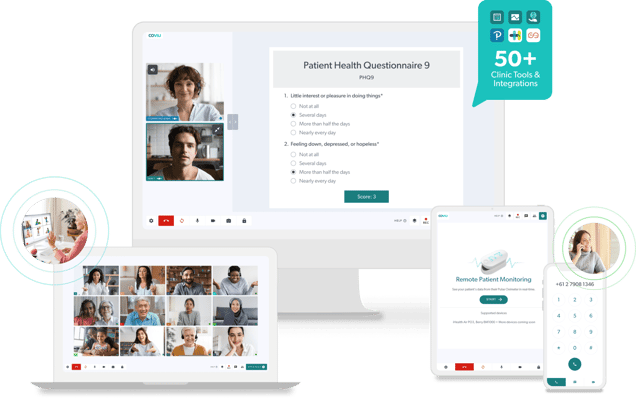School-Based Telehealth Programs
The surge of telehealth education in schools has been prompted by the increasing recognition of its vital role in ensuring the wellbeing of students. With the advent of advanced health technology like Coviu, telehealth has become a powerful tool to provide healthcare services remotely, offering accessibility and convenience. Incorporating telehealth in schools across the United States is crucial because it bridges geographical gaps, guarantees early intervention, and enables specialized care for students.
Telehealth not only reduces disparities in healthcare access but also offers a cost-effective solution for schools, ultimately enhancing students' overall educational experience and solving staff shortages at the same time. Coviu is leading the charge with its purpose-built platform for schools. Read on to find out more about school-based telehealth.
.png?width=680&height=472&name=Addiction%20Medicine%20Diagram%20(34).png)
The Emergence of Telehealth Education in School Settings
Telehealth in school settings refers to the use of digital technology to provide remote healthcare services to students. It involves virtual consultations with healthcare professionals, such as doctors, therapists, or counselors, via video calls or secure messaging platforms. Telehealth works by connecting students with healthcare providers, often speech-language pathologists and behavioral health practitioners to enable assessments, diagnoses, and treatment plans without the need for in-person visits, improving access to care and convenience. Coviu is a leader in purpose-built telehealth for school settings with over 50 in-built tools and clinical features.
The Adoption Curve: Telehealth in Schools
School-based telehealth has experienced significant growth in recent years, addressing healthcare accessibility for students. According to a 2021 study by the National Association of School Nurses, there has been a large increase in the amount of US schools using telehealth compared with previous years. For instance, the Los Angeles Unified School District has partnered with local healthcare providers to offer telehealth consultations to its 600,000 students, reducing absenteeism due to illness.
In North Carolina, the Center for Rural Health Innovation reports that more than 200 schools in underserved areas have implemented telehealth programs, providing students with access to healthcare professionals for physical and mental health support. Such statistical data highlights the widespread adoption of school-based telehealth, improving students' wellbeing and educational outcomes.
Why Are School Districts Turning to School-Based Telehealth?
Adopting school-based telehealth enhances healthcare access for students, especially in rural areas, by connecting them with healthcare professionals remotely. This cost-effective and efficient approach reduces geographical barriers, ensuring timely care and improving overall student wellbeing. But most importantly, telehealth platforms such as Coviu are providing respite for practitioners affected by staff shortages, by providing more flexibility and removing barriers impacting their overall wellbeing.
Addressing Staff Shortages & Practitioner Burnout
School-based telehealth is alleviating staff burnout and shortages by providing support and expertise remotely. It lessens the burden on onsite staff, enabling them to focus on core responsibilities. This innovation also attracts healthcare professionals to work in schools, easing staffing challenges, and enhancing overall staff wellbeing.
Enhancing Access to Healthcare
Telehealth in schools enhances access to healthcare services by connecting students with healthcare professionals remotely. It eliminates geographical barriers, making it easier for students, especially those in rural or underserved areas, to receive timely medical attention. This improved access positively impacts students' overall wellbeing by addressing health issues promptly, reducing absenteeism, and supporting their physical and mental health. Consequently, students' improved health contributes to better academic performance as they can fully engage in their studies without the hindrance of unmet healthcare needs.
Bridging the Gap in Rural Areas
The role of telehealth education in rural school districts is pivotal in bridging healthcare gaps. Telehealth enables remote consultations with healthcare professionals, mitigating geographical challenges common in rural areas. It provides students with access to timely healthcare, including physical and mental health services, that might otherwise be lacking. This promotes their overall wellbeing and academic success.
Case studies highlight the positive impact of telehealth in rural schools. For instance, in a rural Arkansas school district, telehealth reduced absenteeism by 50% by providing students with easy access to medical care. In Dallas, a school-based telemedicine initiative facilitated around 10,000 virtual consultations across 16 school districts spanning over 100 schools. This program has garnered parental satisfaction as it empowers them to save both time and money on healthcare services in a remote area, typically difficult to service. These examples underscore how telehealth education can bridge healthcare gaps and enhance the lives of students in rural areas.
Cost-Effectiveness and Efficiency
Implementing school-based telehealth programs reduces healthcare costs by minimizing travel expenses and missed workdays for parents. It streamlines healthcare delivery, allowing for quicker consultations, assessments, and interventions. This efficiency not only saves time but also optimizes the use of healthcare resources, benefiting both students and healthcare providers.
.png?width=680&height=472&name=Addiction%20Medicine%20Diagram%20(33).png)
Implementing Telehealth Education: A Step Towards a Healthier Future
This blog will now explore strategies for school districts to integrate telehealth into their healthcare services, discussing its benefits and implementation considerations. You can learn more about Coviu’s offering for schools.
Preparing Schools for Telehealth Integration
To integrate telehealth, schools must assess needs, secure funding, and ensure legal compliance. Collaboration with healthcare providers is key. Partnerships with telehealth companies can offer technology solutions, training, and ongoing support, facilitating successful implementation and improving students' access to healthcare services.
Best Practices and Guidelines
To enhance school-based telehealth programs, crucial steps must be taken. These include thorough needs assessments, securing funding, and legal compliance. Investing in reliable technology and staff training ensures smooth telehealth operations. Engaging parents, forming healthcare partnerships, continuous evaluation, and community outreach all contribute to program effectiveness and reaching those in need.
Conclusion
Integrating telehealth in schools is crucial for enhancing healthcare access, particularly in underserved areas. It improves student wellbeing, academic performance, and reduces absenteeism. Future prospects suggest continued growth, with telehealth becoming a standard in education, ensuring equitable healthcare for students and addressing evolving health challenges.
Discover how Coviu's cutting-edge telehealth solutions are revolutionizing healthcare in schools. Explore our innovative platform designed to enhance accessibility, efficiency, and student wellbeing. Join us on a journey towards a healthier and more connected future for educational institutions.
Try Us Out

Ready to take the next step? Experience the benefits of Coviu's virtual care software today with a free 2-week trial - no credit card required. To book a call with one of our friendly team members here.




_TAW2023.jpg)
